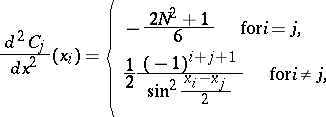Fourier pseudo-spectral method
A type of trigonometric pseudo-spectral method (cf. Trigonometric pseudo-spectral methods) used to solve differential and integral equations. See also Chebyshev pseudo-spectral method.
The Fourier pseudo-spectral method is used for problems in which there is a natural periodicity. In multi-dimensional problems it should be used only in those directions with periodic boundary conditions. In non-periodic directions, Chebyshev methods, finite element or difference methods of high order should be used.
Suppose the equation  is to be solved where
is to be solved where  is a differential operator,
is a differential operator,  is a given periodic function and
is a given periodic function and  is an unknown periodic function (period
is an unknown periodic function (period  ). In the Fourier pseudo-spectral method, the solution
). In the Fourier pseudo-spectral method, the solution  is approximated by a trigonometric polynomial
is approximated by a trigonometric polynomial  that interpolates
that interpolates  at equally spaced points
at equally spaced points  ,
,  .
.
The Lagrange interpolation polynomial (cf. also Lagrange interpolation formula) has the form  , where
, where  is the Cardinal function, having the form
is the Cardinal function, having the form
 |
An equivalent way of defining the interpolating polynomial is by the discrete Fourier transform:  , where the Fourier coefficients are
, where the Fourier coefficients are
 |
 |
In the Lagrange polynomial or "grid-point representation" , the problem can be written as  , where
, where  The form of
The form of  can be found through differentiation of the Cardinal function:
can be found through differentiation of the Cardinal function:  ,
,
 |
 |
to give a few. The derivative matrices are full and  operations are required for evaluation.
operations are required for evaluation.
The problem can also be formulated using the spectral coefficient representation. Derivatives are found through differentiation of the discrete Fourier series, for example,
 |
and have an  operation count. If the operator
operation count. If the operator  is non-linear or has non-constant coefficients multiplying the derivatives, evaluation of
is non-linear or has non-constant coefficients multiplying the derivatives, evaluation of  is much more complicated.
is much more complicated.
The fast Fourier transform provides a way of switching between grid-point and spectral representations in  operations, instead of the
operations, instead of the  using the definitions above. Derivatives can be accomplished in spectral space and multiplication of non-constant coefficients or evaluation of non-linear terms can be accomplished in grid point space — each with
using the definitions above. Derivatives can be accomplished in spectral space and multiplication of non-constant coefficients or evaluation of non-linear terms can be accomplished in grid point space — each with  operations.
operations.
Particularly for time-dependent problems in which boundary value problems must be solved at each time step, it is very important to minimize operation counts by taking full advantage of each representation and the fast transformation between representations.
As an example, consider the operator
 |
for the time-dependent problem  . Suppose at a particular time the spectral coefficients
. Suppose at a particular time the spectral coefficients  ,
,  , are known. To compute
, are known. To compute  , first the spectral coefficients of the first- and second-order derivatives are found:
, first the spectral coefficients of the first- and second-order derivatives are found:  and
and  . Then both of these arrays are transformed into their grid point representation using a fast Fourier transformation. Then
. Then both of these arrays are transformed into their grid point representation using a fast Fourier transformation. Then  can be evaluated in
can be evaluated in  operations. The complete evaluation of the operator is done in
operations. The complete evaluation of the operator is done in  operations rather than
operations rather than  if done completely in one space. This property becomes even more critical for multi-dimensional problems; the operation counts are
if done completely in one space. This property becomes even more critical for multi-dimensional problems; the operation counts are  versus
versus  for a
for a  -dimensional problem.
-dimensional problem.
References
| [a1] | J.P. Boyd, "Chebyshev and Fourier spectral methods" , Dover (2000) (pdf version: http://www-personal.engin.umich.edu/~jpboyd/book_spectral2000.html) |
| [a2] | D. Gottlieb, S.A. Orszag, "Numerical analysis of spectral methods: Theory and applications" , SIAM (1977) |
| [a3] | C. Canuto, M.Y. Hussaini, A. Quarteroni, T.A. Zang, "Spectral methods in fluid dynamics" , Springer (1987) |
| [a4] | D. Gottlieb, M.Y. Hussaini, S.A. Orszag, "Theory and application of spectral methods" R.G. Voigt (ed.) D. Gottlieb (ed.) M.Y. Hussaini (ed.) , Spectral Methods for Partial Differential Equations , SIAM (1984) |
| [a5] | B. Fornberg, "A practical guide to pseudospectral methods" , Cambridge Monographs Appl. Comput. Math. , 1 , Cambridge Univ. Press (1996) |
Fourier pseudo-spectral method. Encyclopedia of Mathematics. URL: http://encyclopediaofmath.org/index.php?title=Fourier_pseudo-spectral_method&oldid=14397